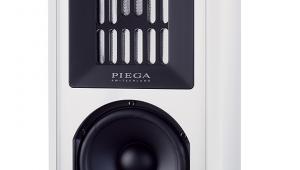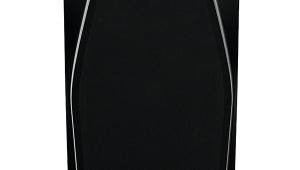Martinlogan Summit X (£13,000)
Blown away by MartinLogan’s Spire earlier this year [see HFN, Apr ’09], I assumed that it would replace the Summit. Before the ink was dry, the Summit X was announced, and at a higher price point to ensure that the gap would prevent customer confusion. But in order to justify the cost difference, for a speaker not that much larger, its performance would have to be instantly, audibly superior. Luckily for ML, the Summit X may be the best hybrid the company has delivered to date.
Note the word ‘hybrid’: unlike the full-range CLX preferred by ESL purists and die-hards, the Summit X is a classic example of MartinLogan’s chief party trick. In my experience, no manufacturer of electrostatic hybrids has arrived at a level near that of the Kansas-based manufacturer when it comes to obliterating any variance between a cone woofer and an electrostatic panel for the upper frequencies.
BY THE BOOK...
Credit for this faultless transition is apportioned by the company to its ‘Vojtko Voiced’ crossover, which applies variable phasing near the crossover point, along with its proprietary ‘Controlled Dispersion PoweredForce’ technology to ‘provide seamless blending with the XStat transducer.’ The user, too, plays a part in assuring this coherent, of-a-whole playback because set-up options ensure that the speaker is easily tailored to the room, the system and the owner’s taste thanks to a number of features, especially the 25Hz and 50Hz level controls for fine-tuning the woofer output on the rear panel.
Both controls are marked for ±10dB adjustment, the 25Hz knob operating at 20Hz and 30Hz and the 50Hz control between 40Hz and 60Hz. As the manual states, as if to prevent those horrible doubts craved by masochistic audiophiles, both settings are determined by ‘room size and construction, system configuration and personal preference.’
Absent from earlier ’Logans are bi-wiring terminals; I was pleased to see that the Summit X only accommodates single wiring, via easy-to-grip, truly functional screw terminals. A third rotary control above the 25Hz and 50Hz rotaries chooses which pilot lights you’d like illuminated, including full-off for those who believe that such things affect the sound. Note that in addition to the stylised ‘M’ on the top surface of the woofer enclosure, the Summit X includes down-lighting below the cabinet. OK, so it’s a gimmick, but it looks wonderful.
KANSAS ILLUMINATIONS
It doesn’t stop there. The rear panel’s multi-colour LED shows the current status of the amplified ‘PoweredForce’ woofer system, with no illumination meaning ‘no power’, blue indicating play mode (the speaker auto-senses an audio signal), and red meaning standby, a state entered when no audio signal is detected for approximately 15 minutes. There’s also a ‘Safe’ mode when the red light flashes, if the Summit X’s temperature has exceeded the normal operating range, usually corrected by not using the speaker for a brief period. Below this is a second LED for ‘Diaphragm Charge Status’. It glows green when the Summit X detects an audio signal and the ESL diaphragm is properly charged.
Lastly, the 3in-tall modular feet adjust vertical dispersion over a 12 degree range, and they can be fitted as spikes, for carpeted rooms, or with floor-friendly rubberised toes for hard surfaces (see picture, right). It’s worth playing with the speaker’s tilt because, as any panel speaker devotee will tell you, this can affect everything from imaging to tonal balance because it does, after all, adjust arrival times of speaker-to-ear.
LOGAN’S RUNNING
Fed by a Rotel RSX-1067 receiver or McIntosh C2200/MC2102 valve combination, I used the ’Logans in both stereo and multichannel systems. But it was a Blu-ray demo disc from DTS that showed the low-frequency mettle of the Summit X. Switching off the Descent subwoofer, the Summit X delivered such convincing bass and mass during the clip of Alice Cooper performing ‘School’s Out’ at Montreux in 2005 that it ranked as one of the most authentic-sounding live performances I’d heard through the AV system. How so? That lower cabinet houses two 10in aluminium-cone drivers, each with its own 200W amp. ML says the system works down to 24Hz, ‘from an enclosure only about the size of a case of wine.’ How truly apt: it was a rich and meaty as a 20-year-old Barolo.
It’s worth keeping in mind, then, how small this system is: only 1548x322x540mm, the upper section being the signature curved, see-through panel that has made MartinLogans so distinctive. And with natural metal rather than black surrounds, they’re even less visually intrusive than their dimensions suggest. But they’re so pretty, who can object to them?
Because the crossover point is stated as 270Hz, the company suggesting that it operates as a dipole down to 160Hz, my belief – that the transition from enclosure to panel is as smooth and undetectable as any hybrid design would require – was reinforced. I hate to belabour the point, especially as I’m not a bass obsessive, but one must get past the imagined and/or intrinsic failings of all types of hybrids if one is to feel at home with the best part of the Summit X: the midband on up.
While the remastered Beatles catalogue is still a month away as I write, I was drawn to the 2004/2006 USA remixes on CD of their American albums. On the more sparse recordings – ‘I’ll Follow The Sun’, ‘Yesterday’ and the like – the sensation of air around the sounds was uncanny, giving shape and placement to each performer. However astounding the Beatles canon, it is a body of work fashioned in a studio, at a mixing desk. And yet the presentation stands defiant against those who would argue that the only recording worth hearing, when assessing sound quality, is a live event. For those who want their music to seem real, and in the room, the Summit X is, generically speaking, an equal opportunity transducer.
SATURATION POINT
No-one expects the openness and space-filling capabilities of multichannel SACDs or DVDs to emerge from two-channel CDs or LPs, but that’s how convincing the ’Logans are in terms of dispersion. You forget that you’re auditioning a stereo recording, their curved panels, tilted and toed-in with Wilsonian precision, saturating the space in front of you with such completeness that you’d swear an extra channel or two were augmenting the soundstage.
‘Pinball Wizard’ off the Smithereens’ re-make of Tommy was played right after the Blu-ray of the Who performing it 39 years ago at the Isle of Wight festival. As much as it is an endorsement of the group’s ability to mimic Townshend and Co, the sheer room-filling mass and power of the percussion oozed presence. I can’t stress this enough: few speakers I’m able to name can both ‘disappear’ and deliver massive bass. ESLs do the former, dynamics do the latter. Perhaps only hybrids can do both equally well?
But enough of the spatial concerns and the bass. On the Soggy Matzoh Boys’ ‘Man Of Constant Tsuris’, the banjo possessed precisely the twang and metallic sheen – mixed with the sound of the stretched and tuned head – that sends a sonic shimmer into a room. Track after track, new or more authentic sensations were enjoyed, thanks to a mix of sublime naturalness and incisive detailing.
A CHANCE MEETING
But a chance, surprising choice made me fall in love with the Summit X. Levon Helm was, for this listener, the rural soul of the Band, its yee-hah element, and the one genuine American. His astonishing new album, Electric Dirt (and, yes, it features a couple of Muddy Waters tracks, though not from Electric Mud), is the rootsiest release I’ve heard this century, so gritty you can smell the cowflap. Its textures include electric guitar, Helm’s bone-dry drumming, slithery bass, screechy fiddle, resonant harmonium, punchy brass and other sonic flavours that place you on the set of Deadwood or McCabe & Mrs Miller. These ’Logans turn your room a sepia hue.
Hovering over the entire proceeding is Helm’s distinctive, nasal country carolling. All of this coalesces through the Summit X with a texture I can only liken to a burlap weave. The speakers take on the character of the music, which is as it should be. I’m certain that if I fed it the Cars’ Greatest Hits, my room would be chrome-plated.
VERDICT
It’s no surprise that I adore the Summit X. Even ignoring its non-sonic charms – the looks, the ‘customisability’ – it seduces the listener with realism and a sense of scale which, for me, embody precisely the difference between the high-end and everything else. If you value openness and transparency, and speakers that seem to ‘disappear’, the Summit X will own your heart from its first notes
Originally published in the November 2009 issue

























































